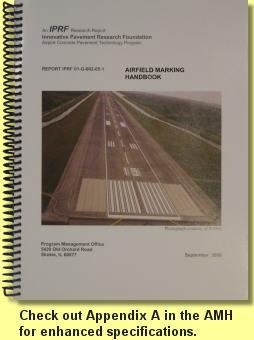 |
 |
Suitable SpecificationsBy Donna SpeidelCharlie bought a suit from a reputable men's clothier for a wedding we attended last weekend, and after tailoring, picked it up a few days before we left. He tried it on in the store and noticed puckering around the shoulders where the sleeves were attached. The tailor whisked the jacket out of his hand and retreated to the back of the store to steam the areas, which would "surely do the trick." But it didn't. Charlie had to take the suit the way it was since he had to wear it the next weekend, but he wasn't pleased. He expected the suit that he bought from that clothier to be of good quality, certainly when it came to stitching the arms to the body of the jacket. Expectations convey an understood standard. When expectations are not met, at least with clothing, we have the right to return it and make the product right. There is a written standard for the installation of airfield markings. But somehow when the product does not meet those standards, it isn't recognized very often. Problems with the markings don't show up right away like the puckering of the sleeves on the suit jacket, and so the airports don't even recognize they are not getting what they are paying for until after payment has been made.
Item P620 in AC 150/5370-10D is the "how to" apply markings, but they are guidelines that set forth minimum standards for owners, engineers and applicators. Minimums set a baseline; and from there engineers, airports, and applicators are free to raise the bar; and Sightline has been striving to do just that for a long time. Within the Airfield Marking Handbook, authored by Sightline and its IPRF research team, Appendix A is a modified version of Item P620 filled with italicized modifications to the minimums. Those modifications establish suggested performance standards and criteria that, if specified and enforced, will usher in a "new and improved" standard for airfield markings. When that happens, airports will begin to fulfill their expectations and get their money's worth. Charlie was able to return his jacket for a new one. It was a lot easier for him to remedy his problem than it is for an airport to fix poor workmanship with the markings just applied. The ability to distinguish what makes a good marking and how to expect and get more is what we teach our Airfield Marking Symposiums participants; you'll gain a new perspective. Last AMS this year is in Fort Myers, FL, November 8-10, 2010. |

 Whether an airport has its own crews or a contractor performs the work, airports should know
what to expect and have methods for checking those standards... performance standards. The FAA has
provided guidance for airfield marking standards with published advisory circulars: AC 150/5340-1K
(just published 9/3/10) (see "
Whether an airport has its own crews or a contractor performs the work, airports should know
what to expect and have methods for checking those standards... performance standards. The FAA has
provided guidance for airfield marking standards with published advisory circulars: AC 150/5340-1K
(just published 9/3/10) (see "